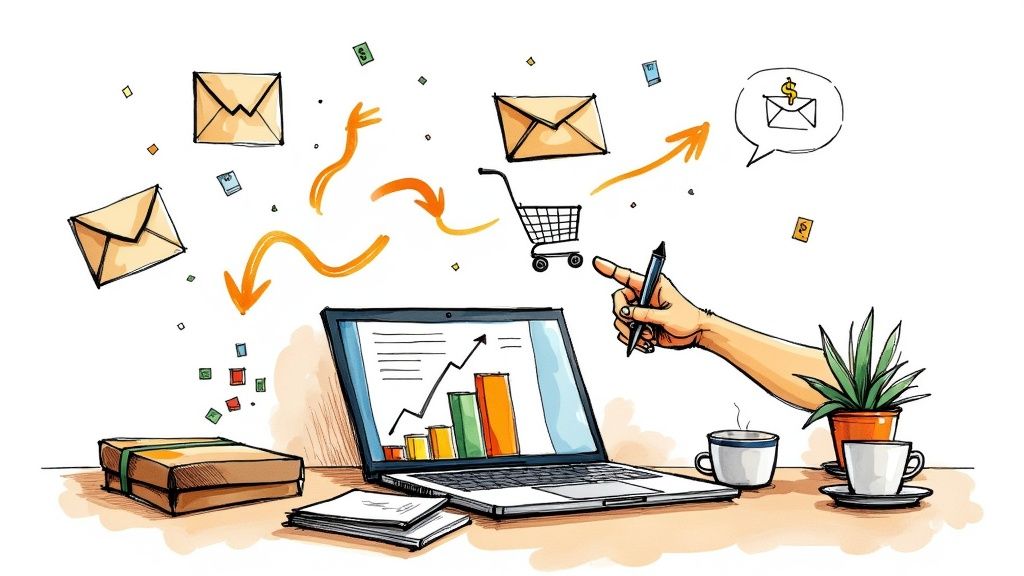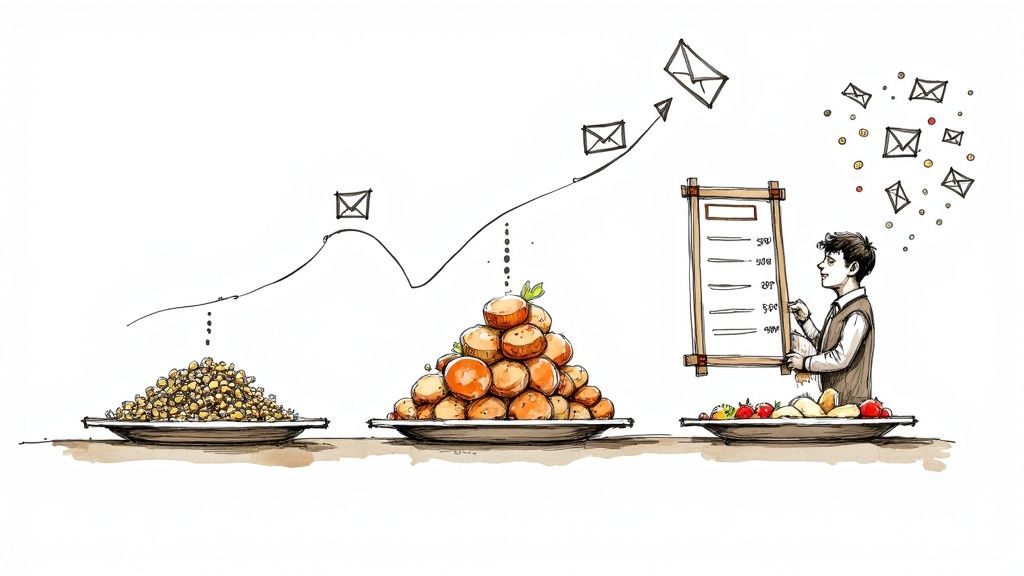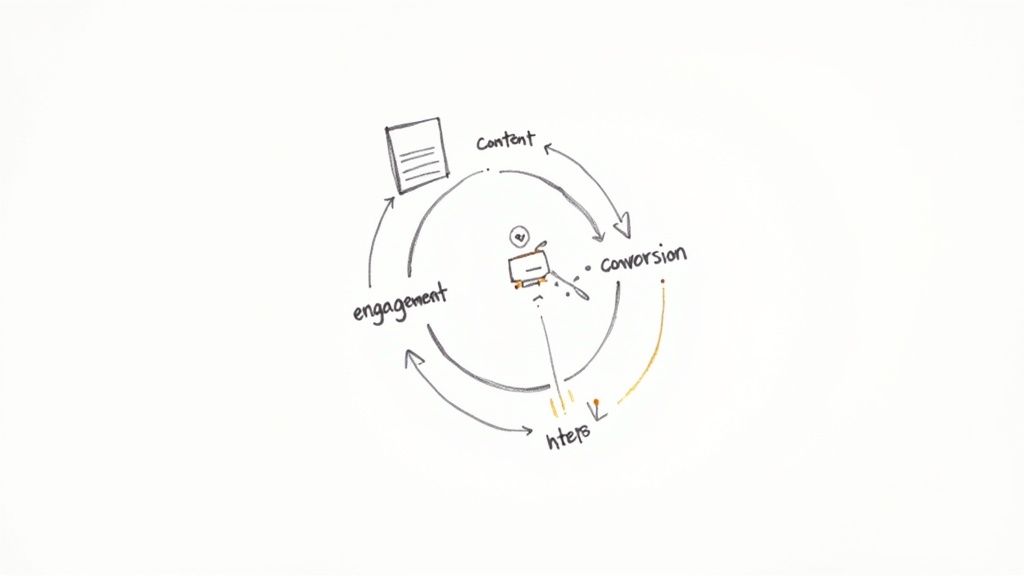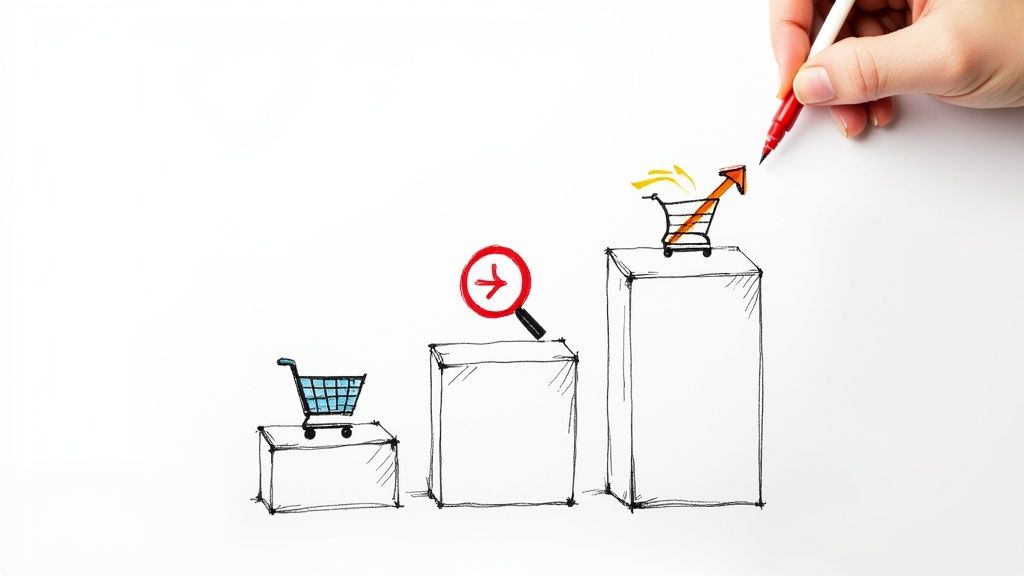Boost Sales with Marketing Automation for Ecommerce
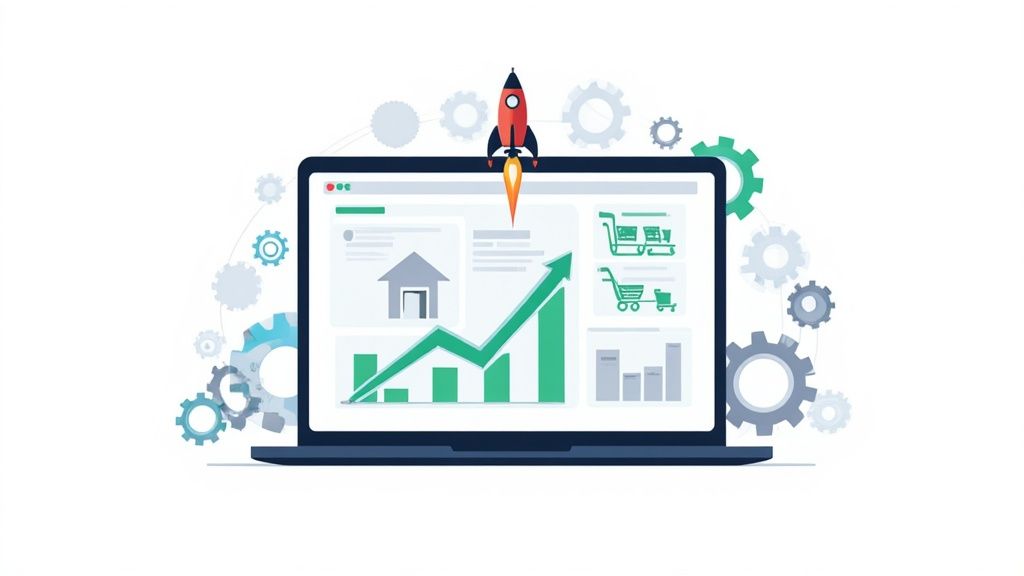
13 mins
5/23/2025
Joe Ervin
- marketing automation
- ecommerce tools
- email flows
- sales growth
- customer journey
Why Smart Stores Use Marketing Automation
Running an online store requires significant effort. Attracting new customers, generating sales, and maintaining customer satisfaction are ongoing challenges. If you're handling everything manually, it can be incredibly time-consuming. Marketing automation offers a solution, enabling you to manage these tasks more efficiently, even with limited staff. Think of it as having a virtual team working around the clock.
Automate More, Work Less
Imagine simultaneously sending emails, managing social media posts, and presenting each shopper with the perfect offer. This is the potential of marketing automation. It liberates you from repetitive tasks. For instance, instead of manually sending individual welcome emails, you can configure a single automated process. This automation frees up your time to focus on strategic planning and business growth.
You might be interested in: How to master email and SMS.
Compete With the Big Guys
Marketing automation empowers small businesses to compete effectively with larger brands. While large corporations often have extensive teams, smaller businesses may not. Automation levels the playing field. It allows you to provide shoppers with comparable high-quality experiences. Personalized offers, prompt email responses, and engaging social media posts all contribute to customer satisfaction. And satisfied customers are more likely to make repeat purchases.
Email and Social Media: Your Automated Helpers
Email flows are a straightforward method for automatically increasing revenue. You set them up once, and they can generate over 20% of your sales. Consider a welcome email flow. It greets new customers and introduces them to your featured products. Abandoned cart emails remind shoppers about items left in their online shopping carts. These automated emails work tirelessly on your behalf.
Cultivating a social media following also contributes to marketing automation. A dedicated audience provides a platform for product promotion. Scheduling posts in advance and automating their release maintains audience engagement and interest in your store. Furthermore, the fact that 79% of businesses now utilize marketing automation underscores its significance for achieving success. Find more detailed statistics here.
Email Flows That Sell While You Sleep
Email flows are like having a dedicated sales team working around the clock. They're always on, ready to connect with customers and boost your sales. This section will guide you through setting up four effective email flows: the welcome series, abandoned cart emails, post-purchase emails, and win-back campaigns. No technical expertise is required to implement these powerful tools.
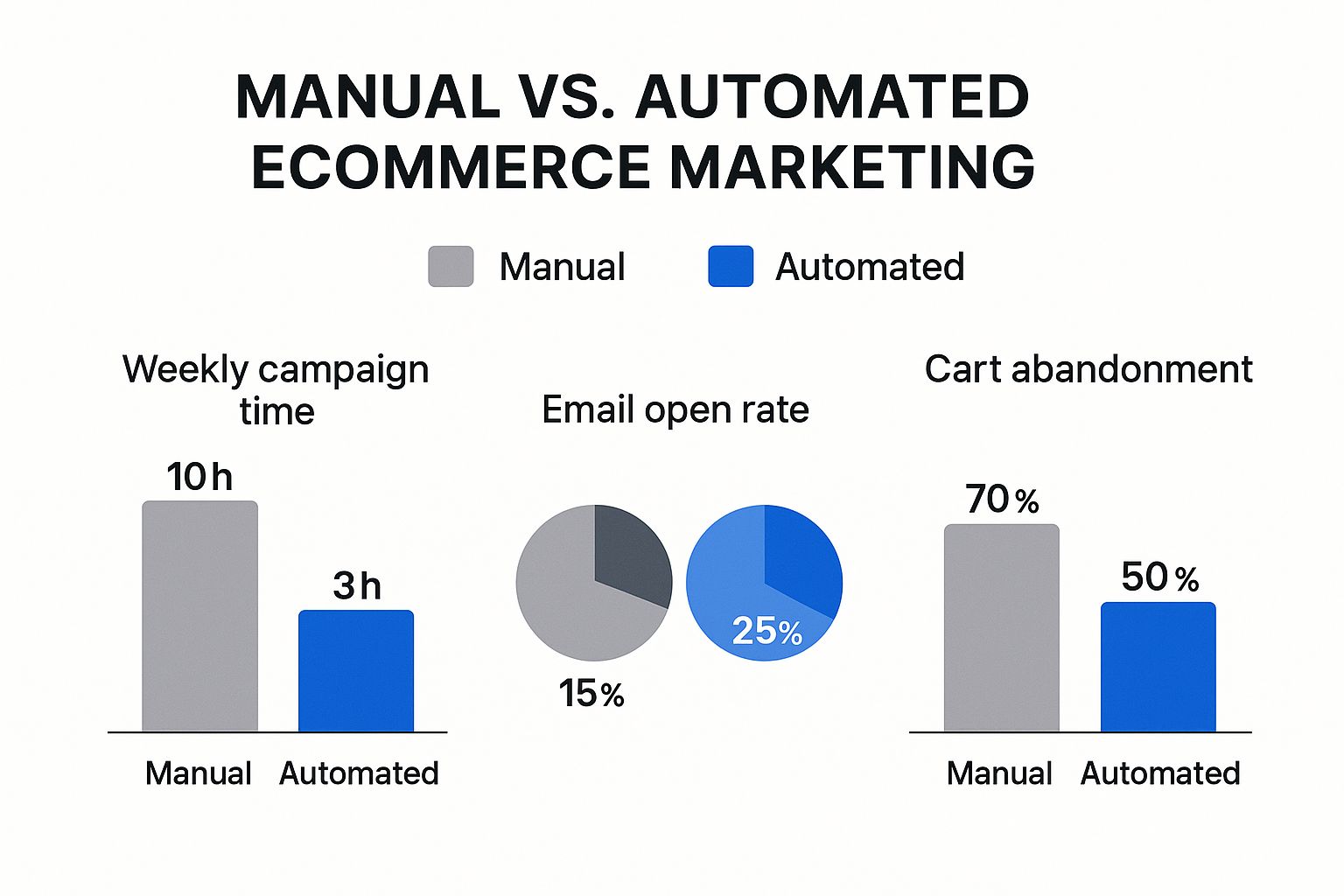
The infographic above highlights the difference between manual and automated marketing. It compares time investment, email open rates, and abandoned cart rates. Automated marketing clearly saves time, increases engagement, and recovers potentially lost sales.
Four Essential Email Flows
Welcome Series: A welcome series greets new subscribers and introduces them to your brand. By showcasing your top products, you can turn subscribers into loyal customers.
Abandoned Cart Emails: Online shoppers often add items to their cart but leave without completing the purchase. An abandoned cart email reminds them of those items and gently nudges them to finish checking out, recovering otherwise lost sales.
Post-Purchase Emails: After a customer makes a purchase, a post-purchase email is a great way to thank them for their order. It's also an opportunity to suggest related products or offer a discount on their next purchase, encouraging repeat business.
Win-Back Campaigns: When a customer hasn't purchased from your store in a while, a win-back email can re-engage them. Offer a special discount or highlight new products they might be interested in, reminding them of the value you offer.
Let's explore these key email flows in more detail with a comparison table showing their benefits and implementation time.
To help you choose the right email flows for your business, the following table compares their purpose, open rates, sales impact, and setup time.
Email Flow Type | Main Purpose | Typical Open Rate | Sales Impact | Setup Time |
|---|---|---|---|---|
Welcome Series | Introduce your brand and products to new subscribers | High (often above 50%) | Converts subscribers into first-time customers | Moderate |
Abandoned Cart | Recover lost sales by reminding shoppers of items in their cart | Moderate to High (around 40%) | Significant, recovering a substantial portion of potentially lost sales | Low |
Post-Purchase | Thank customers and encourage repeat purchases | Moderate | Builds customer loyalty and increases lifetime value | Low |
Win-Back | Re-engage inactive customers | Lower than other flows | Helps retain customers and reactivates past purchases | Low |
This table demonstrates the diverse ways email flows can support your business goals, from welcoming new customers to rekindling relationships with inactive ones. Each flow has its own strengths and contributes to a comprehensive email marketing strategy.
How to Write Effective Emails
Automated emails are valuable, but they must also be well-crafted to be effective. Here are some essential tips to remember:
Strong Subject Lines: Capture attention and encourage recipients to open your emails with compelling subject lines.
Clear and Concise Content: Get straight to the point and make your message easy to understand.
Compelling Call to Action: Tell your readers exactly what you want them to do. Use clear calls to action, such as "Shop Now" or "Learn More."
Personalize When Possible: Add a personal touch by using the customer's name or referencing their past purchases.
Building a Strong Social Media Presence
Building a strong social media presence is another way to automate marketing efforts and reach a wider audience. Platforms like Facebook and Instagram provide tools to schedule posts, ensuring consistent engagement with your followers. Sharing product updates and engaging content keeps your store top-of-mind and fosters a sense of community. For more content marketing strategies, consider resources like Tips to boost content marketing.
Email flows are a straightforward yet powerful tool for driving sales growth. Automated emails boast impressive performance metrics: 52% higher open rates, 332% higher click rates, and a staggering 2,361% increase in conversion rates compared to standard emails. Learn more about email marketing statistics. With a little upfront effort, you can implement these automated flows and witness a significant boost in revenue. Remember, these automated emails can generate over 20% of your total sales, acting as a silent yet highly effective sales force.
Building a Social Media Machine That Works For You

Tired of posting daily with little to show for it? Instead of constant posting, build a social media system that fuels business growth, even when you're not actively managing it. This section reveals how to efficiently plan content, engage with followers, and measure the effectiveness of your social media strategies.
Plan Posts Like a Pro
Think of your social media presence as a garden. Consistent nurturing and planting (posting) are essential for growth. A content calendar is your roadmap – a simple plan outlining what you'll post and when. The key is to strike a balance between engaging, informative content, and promotional posts showcasing your products.
For instance, if you're selling shoes, share tips on leather care. Follow up with a post announcing your latest shoe sale. This diverse approach keeps your audience interested and encourages them to return.
Talk To Your Followers
Social media is a two-way conversation. Don't just broadcast; engage with your followers. Respond to comments, answer their questions, and proactively ask for their input. This fosters trust and creates a sense of community around your brand. Remember, satisfied followers often become loyal customers.
Tools That Make it Easy
Various tools simplify social media management. Some offer scheduling features, allowing you to plan posts in advance. Others provide analytics to track your performance. For consistent email marketing, consider a reliable email hosting solution. This frees up your time to focus on your customers, not the technical details.
Turn Followers Into Buyers
Your followers are a valuable asset – they've already expressed interest in your brand. Now, transform that interest into sales. Provide exclusive discounts, early access to new products, and engaging contests or giveaways. Make it exciting and rewarding to be part of your online community.
Measure What Matters
Not all social media metrics are created equal. Prioritize those that directly influence sales. While likes and shares indicate engagement, website clicks and sales demonstrate tangible results. Track how many visitors arrive at your store from social media and their conversion rates. This provides concrete evidence of your social media success.
Email marketing and social media work hand-in-hand. Automated email flows can generate over 20% of your revenue, nurturing leads and driving conversions. Meanwhile, social media builds brand loyalty and expands your reach. By setting up these systems and making occasional adjustments, you can establish a powerful engine for sustained growth.
AI Tools That Know What Your Customers Want Next
AI isn't just for big businesses anymore. Small and mid-sized stores are using AI to personalize the shopping experience, even on a budget. This helps create effective marketing automation for ecommerce. This section explores user-friendly AI tools and how they can increase sales.
Smart Suggestions For Happier Shoppers
Think about how Netflix suggests shows you might enjoy. AI tools do the same thing for your online store. They analyze customer browsing and purchase history to recommend other products they might be interested in. This makes shopping more enjoyable and convenient, ultimately leading to higher sales.
For example, if someone buys running shoes, AI might suggest running socks or shorts. These smart suggestions create a win-win: more sales for you and a better shopping experience for your customers.
Dynamic Pricing and Targeted Offers
AI can also adjust prices based on demand. If a product is flying off the shelves, the price might increase slightly. If it's not selling well, the price might decrease. This dynamic pricing strategy helps you maximize profits. AI can also create targeted offers for specific customers. Imagine sending a discount code only to those who abandoned their carts. That’s the power of personalized marketing.
The use of AI in marketing is rapidly expanding. In fact, nearly 20% of marketers plan to incorporate AI into their marketing strategies by 2025. Explore this topic further. This growth demonstrates the increasing importance of AI for businesses. It automates tasks, personalizes experiences, and optimizes decision-making, resulting in increased sales.
To help you find the right AI tool for your business, we've put together this comparison table:
AI Tools That Boost Store Sales
Find the right AI marketing tools for your ecommerce business size and goals
Tool Type | Main Job | Setup Effort | Typical Results | Best For |
|---|---|---|---|---|
Product Recommendation Engine | Suggests products based on browsing history | Low | Increased average order value, improved customer engagement | All business sizes |
Dynamic Pricing Software | Adjusts prices based on demand and competition | Medium | Increased revenue, optimized pricing strategy | Medium to large businesses |
Personalized Email Marketing Platform | Sends targeted emails based on customer behavior | Medium | Improved conversion rates, reduced cart abandonment | Small to large businesses |
This table highlights some of the most common AI marketing tools, their primary functions, and their potential benefits. As you can see, there are options for businesses of all sizes and varying levels of technical expertise.
Getting Started With AI: Simple Steps
Integrating AI into your store is easier than you might think. Start with basic tools that integrate with your existing systems. These tools often include features like product recommendations and targeted discounts.
As your business expands, you can implement more advanced AI solutions. This phased approach allows you to learn the basics before investing in complex tools. Many store owners begin with simple AI integrations and gradually add more as they become comfortable with the technology. This approach minimizes costs while maximizing results.
Email marketing and social media can significantly boost your sales. For instance, automated email flows can generate upwards of 20% of store revenue. These automated emails can include cart abandonment reminders, welcome series, and more. Building a social media following allows you to consistently promote your products. Combining these strategies can optimize your sales potential.
Turn First-Time Buyers Into Loyal Fans Automatically
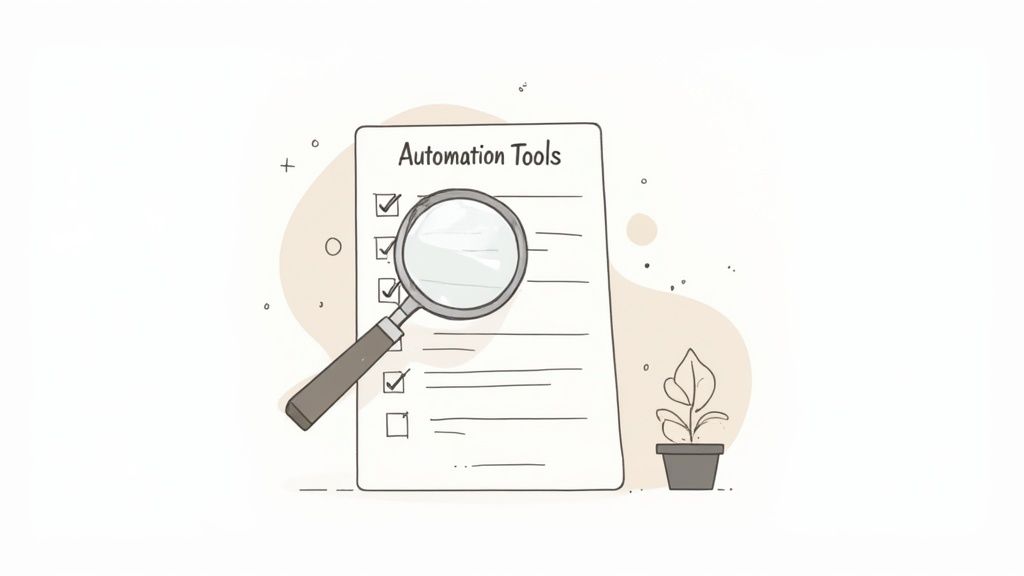
Acquiring new customers is a primary focus for many businesses. But what about keeping them? Customer retention is just as crucial for long-term success. This section explores how to automate the entire customer journey, transforming first-time shoppers into devoted brand advocates.
The Five Stages of a Customer's Journey
The customer journey can be divided into five key stages:
Awareness: The initial point of contact, where a potential customer discovers your store.
Consideration: The exploration phase, where customers browse products and evaluate their options.
Purchase: The moment of truth, where a customer completes a transaction.
Retention: The stage where customers return for repeat purchases, building loyalty over time.
Advocacy: The ultimate goal, where satisfied customers recommend your store to their network.
Each stage requires different strategies. Social media platforms like Facebook are effective for raising awareness, while email marketing is excellent for retention. To further enhance the customer experience, consider leveraging AI tools for ecommerce to better understand and anticipate customer needs.
Automation at Every Step
Automated workflows, triggered by specific customer actions, can seamlessly guide shoppers through their buying journey. For instance, a welcome email series can introduce new customers to your brand and highlight your top-selling products.
Abandoned cart emails can gently remind shoppers of items left behind, often recovering potentially lost sales. Following a purchase, a thank you email expressing gratitude and offering a discount on their next purchase fosters loyalty. For more guidance on crafting compelling content that resonates with your audience, check out this article on crafting engaging content.
Real-World Examples From Store Owners
Consider a scenario where a customer adds a shirt to their online shopping cart but doesn't complete the purchase. An automated abandoned cart email serves as a timely reminder. If the purchase remains incomplete, a subsequent email a few days later offers a small discount, incentivizing the customer without being overly aggressive.
This is a prime example of trigger-based marketing. By analyzing customer behavior, you can design automated workflows that feel organic and helpful.
Fixing Gaps in Your System
Essential components of a successful customer journey include a welcome email series, abandoned cart emails, and post-purchase thank you messages. If these elements are missing from your strategy, you're missing valuable opportunities to cultivate loyal customers. This section will help you identify and address those gaps, transforming your store into a customer magnet.
Create a Smooth Experience With the Right Tools
Sophisticated software isn't always necessary to start automating your marketing efforts. Begin with simple email flows and social media scheduling tools like Hootsuite. As your business grows, consider incorporating more advanced tools, such as product recommendation engines and dynamic pricing. The key is selecting tools that integrate seamlessly, creating a smooth and enjoyable experience that encourages repeat business. These automated emails can generate 20% or more of your total revenue.
Your 30-Day Plan: Start Small, Win Big
Feeling a bit lost when it comes to marketing automation? You're not alone. This 30-day plan is designed to help you take small steps and achieve significant results. We'll guide you through weekly actions, focusing on quick wins and providing you with helpful tools, budget-friendly tips, and realistic expectations. Learn from the mistakes of others and pave your way to success.
Week 1: Start With a Welcome
This week, your focus is setting up a welcome email flow. This is simply a series of emails that greet new subscribers. Introduce your brand and showcase your best-selling products. A well-crafted welcome series is an easy way to make a strong first impression and can have a surprisingly large impact on sales. Some businesses even report a 10% order rate from their welcome emails alone.
Week 2: Recover Lost Sales
Next, implement abandoned cart emails. These emails serve as a gentle reminder to shoppers who left items in their cart without completing the purchase. It's a highly effective way to recover potential lost revenue. In fact, abandoned cart emails boast the highest revenue per recipient of any automated email.
Week 3: Connect With Social Media
This week, it's time to organize your social media presence with a social media calendar. Plan your posts for the upcoming month. Strive for a good balance of product promotions and helpful tips or engaging content. Building a strong social media audience cultivates a group of potential customers who are ready to buy. Consider using a tool like Hootsuite to schedule posts in advance and streamline your social media management.
Week 4: Add Some AI
Start exploring basic AI tools that can personalize product recommendations for your customers. Think of how Netflix suggests shows based on viewing history. These tools operate on similar principles, suggesting products based on customers' past browsing and purchase behavior. Begin with simple AI-powered recommendation tools and consider adding more advanced options later on, as needed.
Tracking Your Progress
Each week, take the time to review your key metrics. Are your email open rates and click rates improving? Are sales increasing? This regular monitoring helps you identify what's working and what needs adjustment. Don't be afraid to make small changes along the way. Your automated marketing system should continually improve.
By day 30, you'll have a system in place that works tirelessly for you, 24/7. This system will not only help grow your online store but also free up your time. You’ll finally have ecommerce marketing automation working for you, not against you.
